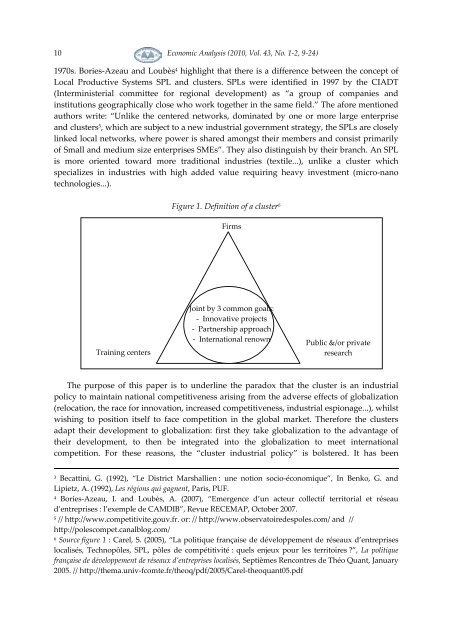Twice a Year Scientific Journal
Twice a Year Scientific Journal
Twice a Year Scientific Journal
Create successful ePaper yourself
Turn your PDF publications into a flip-book with our unique Google optimized e-Paper software.
10<br />
Economic Analysis (2010, Vol. 43, No. 1-2, 9-24)<br />
1970s. Bories-Azeau and Loubès 4 highlight that there is a difference between the concept of<br />
Local Productive Systems SPL and clusters. SPLs were identified in 1997 by the CIADT<br />
(Interministerial committee for regional development) as “a group of companies and<br />
institutions geographically close who work together in the same field.” The afore mentioned<br />
authors write: “Unlike the centered networks, dominated by one or more large enterprise<br />
and clusters 5 , which are subject to a new industrial government strategy, the SPLs are closely<br />
linked local networks, where power is shared amongst their members and consist primarily<br />
of Small and medium size enterprises SMEs”. They also distinguish by their branch. An SPL<br />
is more oriented toward more traditional industries (textile...), unlike a cluster which<br />
specializes in industries with high added value requiring heavy investment (micro-nano<br />
technologies...).<br />
Figure 1. Definition of a cluster 6<br />
Firms<br />
Training centers<br />
Joint by 3 common goals:<br />
- Innovative projects<br />
- Partnership approach<br />
- International renown<br />
Public &/or private<br />
research<br />
The purpose of this paper is to underline the paradox that the cluster is an industrial<br />
policy to maintain national competitiveness arising from the adverse effects of globalization<br />
(relocation, the race for innovation, increased competitiveness, industrial espionage...), whilst<br />
wishing to position itself to face competition in the global market. Therefore the clusters<br />
adapt their development to globalization: first they take globalization to the advantage of<br />
their development, to then be integrated into the globalization to meet international<br />
competition. For these reasons, the “cluster industrial policy” is bolstered. It has been<br />
3<br />
Becattini, G. (1992), “Le District Marshallien : une notion socio-économique”, In Benko, G. and<br />
Lipietz, A. (1992), Les régions qui gagnent, Paris, PUF.<br />
4<br />
Bories-Azeau, I. and Loubès, A. (2007), “Emergence d’un acteur collectif territorial et réseau<br />
d’entreprises : l’exemple de CAMDIB”, Revue RECEMAP, October 2007.<br />
5<br />
// http://www.competitivite.gouv.fr. or: // http://www.observatoiredespoles.com/ and //<br />
http://polescompet.canalblog.com/<br />
6<br />
Source figure 1 : Carel, S. (2005), “La politique française de développement de réseaux d’entreprises<br />
localisés, Technopôles, SPL, pôles de compétitivité : quels enjeux pour les territoires ?”, La politique<br />
française de développement de réseaux d’entreprises localisés, Septièmes Rencontres de Théo Quant, January<br />
2005. // http://thema.univ-fcomte.fr/theoq/pdf/2005/Carel-theoquant05.pdf
















